python detailed installation method
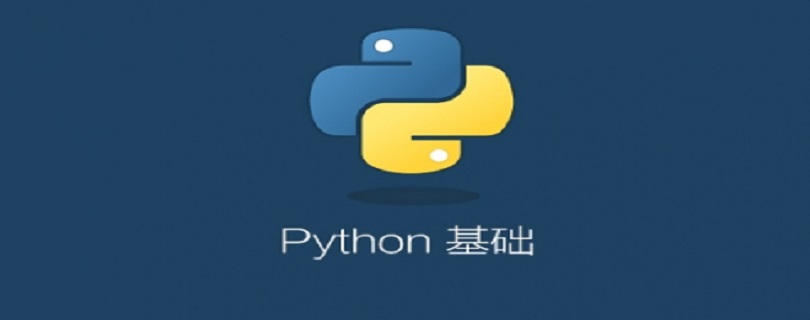
##1. PythonIntroduction
##1.1 What is PythonI believe that many friends in the IT industry know that Python is one of the hottest topics in recent years. In terms of nature, it is not fundamentally different from the well-known C, Java, PHP, etc. It is also a development language, and has advanced to the top 5 of more than 20 mainstream development languages (data comes from the latest TIOBE ranking list).
1.2 The origin and development trend of Python
The past life of Python originated from the originator "Uncle Turtle". In 1989, Guido van Rossum decided to develop a new script interpreter to kill a boring Christmas in Amsterdam. Since then, Python and its founder "Uncle Turtle" have entered the public eye. He hopes that this new language called Python can meet his ideal: to create a language between C and shell that is comprehensive, easy to learn, easy to use, and scalable.
In 1991, the first Python compiler was born. It is implemented based on C language and can call C language library files. After successive versions and innovations, Python reached a very milestone node, that is, version 2.4 in 2004 gave birth to the most popular WEB framework Django! Six years later, Python has developed to version 2.7, which is the latest and more widely used version of the 2.x version so far.
The birth of the 2.7 version is different from the vertical replacement logic of the previous 2.x version. It is a bridge between the 2.x version and the 3.x version in order to maximize the Inherit the new features of version 3.x while trying to maintain compatibility with 2.x.
Therefore, version 3.x has come out before version 2.7. Starting from version 3.0 in 2008, the python3.x system has been developing rapidly, with active version updates, and has been developing to The latest version is now 3.5.2. Version 3.5 is also the mainstream and widely used version in the current 3.x series. The demos of subsequent related programs are all based on version 3.5 by default.
two. Installation of Python
After being ambushed by a big guy in the class, I discovered a very practical public account, which has detailed download methods for almost all software, and the name is Software Installation Butler, I would like to recommend everyone to pay attention to this download method. I moved it here. When downloading, everyone should pay attention to the number of digits of your computer and don’t download the wrong one.
Select the [python-3.7.0] compressed package , right-click and select [Extract to python-3.7.0].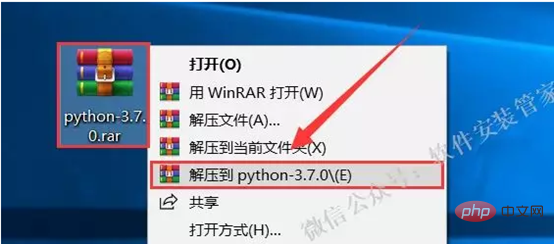 #2. Double-click to open the [python-3.7.0] folder.
#2. Double-click to open the [python-3.7.0] folder.
 3. Right-click My Computer on the desktop and select Properties to view the number of digits of your computer. For 64-bit systems, select [python-3.7.0.amd64] (32-bit The system selects the above) and then right-clicks and selects [Run as administrator].
3. Right-click My Computer on the desktop and select Properties to view the number of digits of your computer. For 64-bit systems, select [python-3.7.0.amd64] (32-bit The system selects the above) and then right-clicks and selects [Run as administrator].
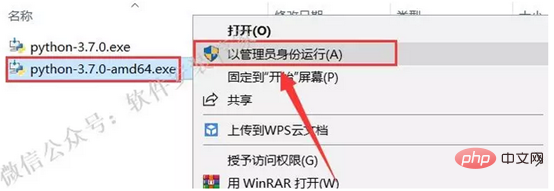 4. Check [Add Python 3.7 to PATH], and then click [Customize installation].
4. Check [Add Python 3.7 to PATH], and then click [Customize installation].
 5. Click [Next].
5. Click [Next].
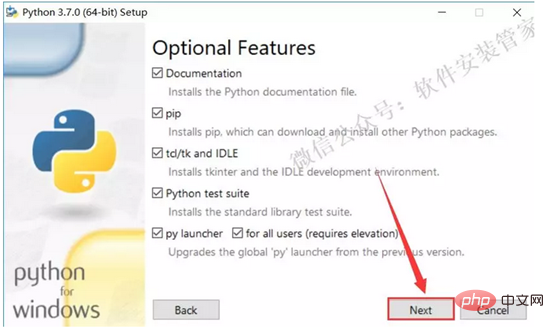 6. Click [Browse] to change the software installation directory. It is recommended to create a new [Python37] folder on the D drive or other disks, and click [Install].
6. Click [Browse] to change the software installation directory. It is recommended to create a new [Python37] folder on the D drive or other disks, and click [Install].
 7. Installing.
7. Installing.
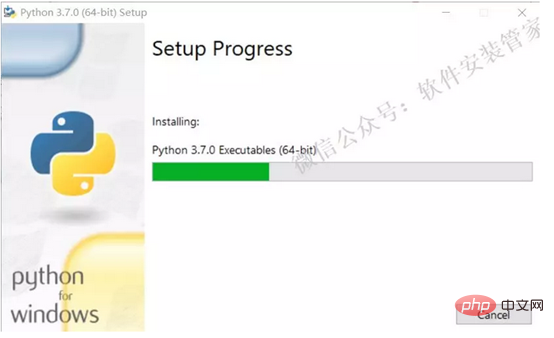 8. When the installation is complete, click [Close].
8. When the installation is complete, click [Close].
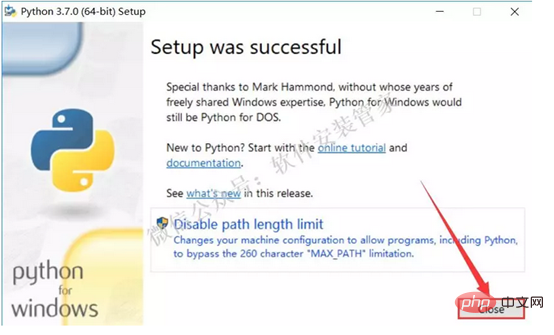 9. Find and open [IDLE (Python 3.7 64-bit)] in the start menu bar.
9. Find and open [IDLE (Python 3.7 64-bit)] in the start menu bar.
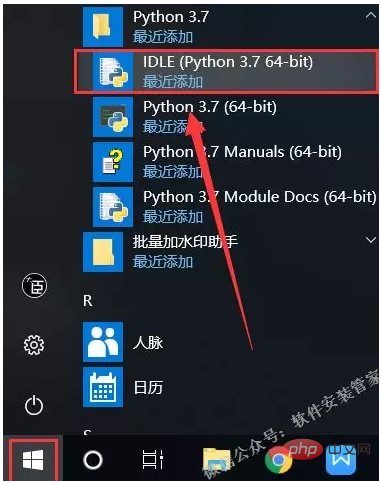 10. The installation is completed.
10. The installation is completed.
Recommended tutorial: "
Python TutorialThe above is the detailed content of python detailed installation method. For more information, please follow other related articles on the PHP Chinese website!

Hot AI Tools

Undresser.AI Undress
AI-powered app for creating realistic nude photos

AI Clothes Remover
Online AI tool for removing clothes from photos.

Undress AI Tool
Undress images for free

Clothoff.io
AI clothes remover

AI Hentai Generator
Generate AI Hentai for free.

Hot Article

Hot Tools

Notepad++7.3.1
Easy-to-use and free code editor

SublimeText3 Chinese version
Chinese version, very easy to use

Zend Studio 13.0.1
Powerful PHP integrated development environment

Dreamweaver CS6
Visual web development tools

SublimeText3 Mac version
God-level code editing software (SublimeText3)

Hot Topics
 1382
1382
 52
52
 PHP and Python: Code Examples and Comparison
Apr 15, 2025 am 12:07 AM
PHP and Python: Code Examples and Comparison
Apr 15, 2025 am 12:07 AM
PHP and Python have their own advantages and disadvantages, and the choice depends on project needs and personal preferences. 1.PHP is suitable for rapid development and maintenance of large-scale web applications. 2. Python dominates the field of data science and machine learning.
 How is the GPU support for PyTorch on CentOS
Apr 14, 2025 pm 06:48 PM
How is the GPU support for PyTorch on CentOS
Apr 14, 2025 pm 06:48 PM
Enable PyTorch GPU acceleration on CentOS system requires the installation of CUDA, cuDNN and GPU versions of PyTorch. The following steps will guide you through the process: CUDA and cuDNN installation determine CUDA version compatibility: Use the nvidia-smi command to view the CUDA version supported by your NVIDIA graphics card. For example, your MX450 graphics card may support CUDA11.1 or higher. Download and install CUDAToolkit: Visit the official website of NVIDIACUDAToolkit and download and install the corresponding version according to the highest CUDA version supported by your graphics card. Install cuDNN library:
 Python vs. JavaScript: Community, Libraries, and Resources
Apr 15, 2025 am 12:16 AM
Python vs. JavaScript: Community, Libraries, and Resources
Apr 15, 2025 am 12:16 AM
Python and JavaScript have their own advantages and disadvantages in terms of community, libraries and resources. 1) The Python community is friendly and suitable for beginners, but the front-end development resources are not as rich as JavaScript. 2) Python is powerful in data science and machine learning libraries, while JavaScript is better in front-end development libraries and frameworks. 3) Both have rich learning resources, but Python is suitable for starting with official documents, while JavaScript is better with MDNWebDocs. The choice should be based on project needs and personal interests.
 Detailed explanation of docker principle
Apr 14, 2025 pm 11:57 PM
Detailed explanation of docker principle
Apr 14, 2025 pm 11:57 PM
Docker uses Linux kernel features to provide an efficient and isolated application running environment. Its working principle is as follows: 1. The mirror is used as a read-only template, which contains everything you need to run the application; 2. The Union File System (UnionFS) stacks multiple file systems, only storing the differences, saving space and speeding up; 3. The daemon manages the mirrors and containers, and the client uses them for interaction; 4. Namespaces and cgroups implement container isolation and resource limitations; 5. Multiple network modes support container interconnection. Only by understanding these core concepts can you better utilize Docker.
 MiniOpen Centos compatibility
Apr 14, 2025 pm 05:45 PM
MiniOpen Centos compatibility
Apr 14, 2025 pm 05:45 PM
MinIO Object Storage: High-performance deployment under CentOS system MinIO is a high-performance, distributed object storage system developed based on the Go language, compatible with AmazonS3. It supports a variety of client languages, including Java, Python, JavaScript, and Go. This article will briefly introduce the installation and compatibility of MinIO on CentOS systems. CentOS version compatibility MinIO has been verified on multiple CentOS versions, including but not limited to: CentOS7.9: Provides a complete installation guide covering cluster configuration, environment preparation, configuration file settings, disk partitioning, and MinI
 How to operate distributed training of PyTorch on CentOS
Apr 14, 2025 pm 06:36 PM
How to operate distributed training of PyTorch on CentOS
Apr 14, 2025 pm 06:36 PM
PyTorch distributed training on CentOS system requires the following steps: PyTorch installation: The premise is that Python and pip are installed in CentOS system. Depending on your CUDA version, get the appropriate installation command from the PyTorch official website. For CPU-only training, you can use the following command: pipinstalltorchtorchvisiontorchaudio If you need GPU support, make sure that the corresponding version of CUDA and cuDNN are installed and use the corresponding PyTorch version for installation. Distributed environment configuration: Distributed training usually requires multiple machines or single-machine multiple GPUs. Place
 How to choose the PyTorch version on CentOS
Apr 14, 2025 pm 06:51 PM
How to choose the PyTorch version on CentOS
Apr 14, 2025 pm 06:51 PM
When installing PyTorch on CentOS system, you need to carefully select the appropriate version and consider the following key factors: 1. System environment compatibility: Operating system: It is recommended to use CentOS7 or higher. CUDA and cuDNN:PyTorch version and CUDA version are closely related. For example, PyTorch1.9.0 requires CUDA11.1, while PyTorch2.0.1 requires CUDA11.3. The cuDNN version must also match the CUDA version. Before selecting the PyTorch version, be sure to confirm that compatible CUDA and cuDNN versions have been installed. Python version: PyTorch official branch
 Python: Automation, Scripting, and Task Management
Apr 16, 2025 am 12:14 AM
Python: Automation, Scripting, and Task Management
Apr 16, 2025 am 12:14 AM
Python excels in automation, scripting, and task management. 1) Automation: File backup is realized through standard libraries such as os and shutil. 2) Script writing: Use the psutil library to monitor system resources. 3) Task management: Use the schedule library to schedule tasks. Python's ease of use and rich library support makes it the preferred tool in these areas.




